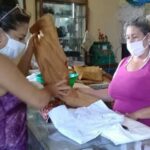Mayabeque, Cuba: A month after starting the production of agromena for the first time, the Base Business Unit (UEB) Gustavo Machín Hoed, from Jaruco, obtained ten tons of this organo-mineral fertilizer, highly demanded in agriculture.
Although the rainfall and the high humidity values associated with Tropical Storm Eta, forced to temporarily stop the production of the product, they have the raw materials, all national, to multiply the yields as soon as the weather conditions allow it.
The Head of Production of this Plant of the Western Mineral Copany, Esteban Pedro Rodríguez, said that agromena is made from a formulation of zeolite, phosphate rock and organic matter.
The market success of this natural fertilizer is based on the new phosphorite deposit, which will be exploited this year, the director of the UEB, Elier Lacher Abascal, said.
They are currently preparing the unit, closed since 2005, where in addition to the phosphoric stone they will obtain gravel, while they plan to produce construction elements there for the housing program.
Cheaper, friendly to the environment and proven effective in protected, semi-protected crops, flower beds, fruit trees and even in gardening, agromena is consolidated in Cuba as a substitute for chemical fertilizers, which are very expensive in the international market.
Lime, bentonite and magnesite are their leading lines, depressed in the last five years due to the obsolescence of their technology, hence they barely accumulate just over 15 thousand tons, in total, until the ninth month of the year.




